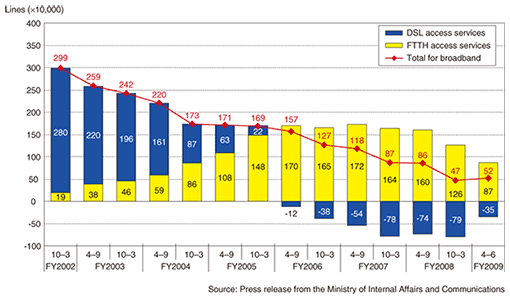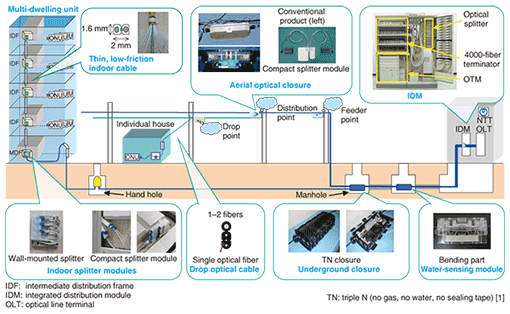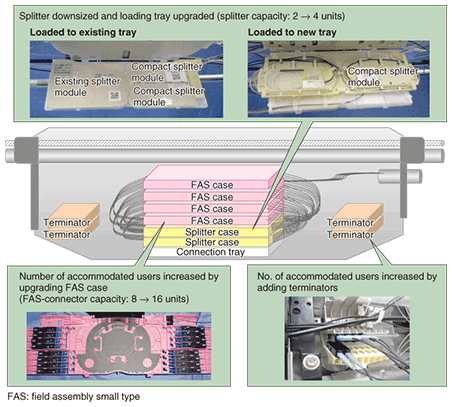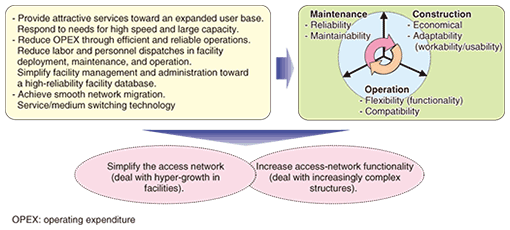 |
|||||||||
|
|
|||||||||
|
Special Feature: NTT Tsukuba Forum 2009 Workshop Lectures Vol. 8, No. 5, pp. 30–35, May 2010. https://doi.org/10.53829/ntr201005sf5  Trends in Optical Access Network Technologies Supporting FTTHAbstractThis article describes trends in broadband services, the latest trends in optical access network technologies, and the direction of future research and development in optical access networks as fiber to the home (FTTH) comes to play a major role in the expansion of broadband services.
1. Trends in broadband servicesAccording to figures released by the Ministry of Internal Affairs and Communications, the number of subscribers to broadband services in Japan reached 30,930,000 as of the end of June 2009. Fiber to the home (FTTH) accounted for 15,890,000 subscribers or more than half of all broadband-service subscribers. The change in the numbers over time can be visualized by comparing the net increase in FTTH subscribers with that of digital-subscriber-line (DSL) subscribers on a half-year basis. The bar chart in Fig. 1 shows that DSL, the original driver of broadband services, has been showing a net decrease in subscribers for every half-year period since April 2006. In contrast, FTTH is continuing to show a more-or-less stable net increase in subscribers, although the magnitude of that increase has been falling slightly owing to recent adverse economic conditions.
One factor behind these trends has been the increasingly slimmer margin between the monthly fees charged for FTTH and DSL services, but customer needs have always leaned toward high-speed, large-capacity data communications. Behind this pursuit for high-speed communications lies the voracious demand for video as in YouTube viewing, video-on-demand (VOD) services, and triple-play services that include the retransmission of digital terrestrial video broadcasts. Such video content is envisioned to be the driving force behind the further expansion of FTTH. In response to these customer needs, NTT launched the HIKARI TV and FLET’S TV services via FTTH in March 2008 and July 2008, respectively. They let users view VOD, CS (communication satellite) broadcasts, and digital terrestrial video broadcasts. Turning for a moment to the state of broadband services in other countries and regions of the world, we see that FTTH services have already begun in North America and that the number of FTTH subscribers there is increasingly steadily. This increase, however, has been slowing somewhat owing to the effects of the economic crises brought on by the “Lehman Shock” of 2008, but the overall trend nevertheless reflects the beginning of a genuine period of FTTH expansion. In Europe, DSL accounts for most broadband services although FTTH trials have recently begun. Since the buried-cable system is being used for most of the cable that will be needed to provide FTTH services, it appears that the conversion to optical fiber will require huge investments in civil-engineering works. At present, broadband service provision is mainly accomplished by the fiber-to-the-curb (FTTC) scheme, but attention is now being paid to the next big trend. In contrast, the deployment of FTTH to provide broadband services is progressing in various Asian countries. The number of FTTH subscribers in China and Korea has already broken the 5 million level, and FTTH services in various Southeast Asia countries have already begun, with the number of subscribers increasing steadily. Several countries in Asia have already entered a period of FTTH expansion. In the above way, the driving force behind broadband services in many countries around the world is gradually shifting to FTTH. 2. Recent trends in optical access network technologiesSince NTT’s launch of FTTH services (B FLET’S) in 2001 (a world’s first), NTT EAST, NTT WEST, and the entire NTT Group have been working together to expand services and construct optical facilities in accordance with NTT’s medium-term management strategy. In March 2008, NTT launched FTTH services (FLET’S HIKARI NEXT) based on the Next Generation Network (NGN), and in March 2009, NTT saw its FTTH service subscriber base break through the 11 million level. NTT Access Network Service Systems Laboratories supports the development of FTTH services, which are expected to continue growing for some time. It is researching and developing technologies for constructing an efficient and economical optical access network to facilitate mass deployment of optical lines and technologies for efficiently and economically operating and maintaining the huge quantity of optical facilities that will be constructed. Researchers are also targeting a grand design for an optical access network. Based on the beyond metal concept, this design focuses on a full-scale optical era in which the features unique to optical communications will be fully exploited. To achieve this design, they are creating construction, operation, and maintenance technologies. Some recent research and development (R&D) achievements are described below as examples of these efforts and illustrated in Fig. 2.
(1) High-capacity splitter technology for distribution-point closures As FTTH service penetration increases and the service menu expands, the capacity for installing optical splitters in aerial optical (AO) closures at distribution points is sometimes insufficient. This has made it necessary to install additional AO closures at these points. In response to this problem, we have upgraded loading trays and downsized optical splitters in AO closures installed at distribution points, enabling up to eight optical splitters or twice the existing number to be accommodated. As a result of this development, we have been able to minimize the installation of additional AO closures (Fig. 3).
(2) Splitter modules for compact MDF/IDF boxes By utilizing optical-splitter downsizing techniques, we have developed splitter modules that can be installed in compact main distribution frame (MDF) and intermediate distribution frame (IDF) boxes. We expect this development to help expand and diversify installation formats with an eye toward introducing optical wiring schemes for small-scale multi-dwelling units. (3) New drop optical cable (economical anti-cicada product) In western Japan, communication faults due to cicadas attempting to lay their eggs on optical-fiber cables have been increasing. This has led NTT to introduce cable products resistant to these insects. Since cicada habitats have been expanding and could extend into eastern Japan, we have developed a new anti-cicada product with uniform nationwide specifications. The existing product, which features a protective barrier, is actually inferior to products that lack such a countermeasure owing to its high material costs and poor workability. Therefore, we modified the materials used for the cable’s outer sheath to eliminate the need for a protective barrier, thereby reducing the cost of the product and facilitating product deployment. (4) Thin, low-friction indoor optical cable [2] The usual way to provide FTTH services in multi-dwelling units like condominium buildings has been to install VDSL (very-high-speed digital subscriber line) equipment on the premises and make use of the existing metallic-wiring facilities inside the building. However, with the aim of reducing operating expenses and providing high-speed communications, NTT is promoting the conversion of all wiring in the building up to each dwelling unit to optical cable. In most cases, the installation of optical facilities in buildings of this type is accomplished by drawing optical cable through the same wiring duct used for metallic facilities. Therefore, to prevent such drawing from adversely affecting existing cable, we have developed a thin, low-friction indoor optical cable. Few indoor optical cables of the conventional type can fit in a wiring duct already containing existing metallic facilities, but our new product allows 20 or more new cables to be drawn through such a duct. (5) New underground optical closure [1] Underground optical closures needed to be opened and closed frequently, even more often than originally expected at the time of development because of changes in demand. This creates more opportunities for water penetration. In response to this problem, we have developed a new underground optical closure that can maintain its water tightness in the face of such opening and closing and an enhanced entry plate for existing closures. These developments were made possible by changing to a sleeve with a three-part structure having a flat joint and using a cable-port structure with axial compression. As a result of these measures, work in underground optical closures has become simple and straightforward, resulting in uniform results no longer dependent on the skill of individual maintenance workers. (6) Fiber selector for small buildings In the maintenance and operation of mass optical facilities, there is an urgent need to research and develop ways of keeping down operating costs associated with system operations, cable-moving construction work, and fault repair. In the past, optical wiring-path tests in small buildings were performed manually by periodically dispatching maintenance workers. To make maintenance more efficient, we have developed a system that enables cables in a small building to be monitored from a neighboring large building equipped with an optical testing module by installing a specialized small-scale (low-fiber-count) optical fiber selector in the small building. This system, which can monitor up to 15 cables, eliminates the need to dispatch maintenance workers in many cases. (7) Advanced underground water-sensing technology [3] Water sometimes penetrate underground optical closures at more than one location. To enable several water-penetration locations to be detected at the same time, we have developed two key technologies: one is to optimize the bending radius and bending angle of water-sensing modules and the other is to insert a marker that simplifies the isolation of water-penetrated facilities by making use of the stable reflection characteristics of a fiber grating. These technologies are expected to make the maintenance of underground optical cables much more efficient. 3. Future directions of optical access network R&DTo date, we have been focusing on the periods covering the dawn of FTTH and its initial penetration, and we can feel that R&D has progressed in terms of cost efficiency and supply and demand (adaptability). In other words, R&D has so far been centered about the axis of construction. If we now turn our attention to the upcoming period of stable growth, we must consider operation and maintenance in keeping with an increase in optical facilities in addition to achieving further reductions in construction costs. In short, there is a need for R&D centered about the three axes of construction, operation, and maintenance to minimize total costs from comprehensive and multifaceted viewpoints that attempt to maximize every item (Fig. 4). In other words, it will not be sufficient to simply increase transmission speeds to achieve a high-speed, large-capacity optical access system. It will also be important to ensure compatibility with the existing GE-PON (Gigabit Ethernet passive optical network) system and to give the optical access network flexibility and high functionality to deal appropriately with user movement and service migration, which are features typical of a stable growth period.
If we look at the age composition of NTT employees, we can foresee the workforce capable of dealing with the access network being rather smaller. Since the quantity of optical facilities will be increasing from here on, making access-network-related work more efficient is a pressing issue that cannot be ignored. To put it another way, operation technology that can help make work even more efficient will be an essential element of the future access network. In this regard, the development of technology for constructing a detailed facility database is an important theme toward the development of an operation system that can help reduce labor in circuit deployment and maintenance operations. Simplification of the access network must also be thought of as another technique for making work more efficient. Considering that maintenance and operation work will become increasing significantly owing to the coexistence of metallic and optical facilities, we can expect the simplification derived from having only optical facilities to have a big effect in economical terms by reducing operating expenses. In short, efficient R&D of technology that supports network migration, as in service/medium switching technology, is an important issue, and we need a way of achieving it. 4. ConclusionIn Japan, the growth of FTTH services, which now account for more than half of all broadband-service subscribers, is expected to continue. Looking forward, we aim to bring FTTH to the next level and assist every company in the NTT Group with their FTTH-related projects. We will also continue in our efforts to produce more R&D results and make a superb broadband network. References
ProfileCareer highlightsProject Manager, Second Promotion Project, NTT Access Network Service Systems Laboratories. Masahito Arii received the B.E. degree in electrical engineering from Waseda University, Tokyo, and the M.E. degree in computer science from Tokyo Institute of Technology in 1983 and 1985, respectively. He joined NTT in 1985 and engaged in the development of optical access network systems. He moved to NTT COMWARE in 2006 and was responsible for the development of optical access network operation support systems as Senior Manager. He has held his position since 2009. |
|||||||||











